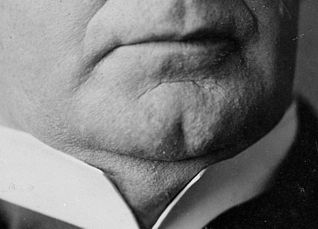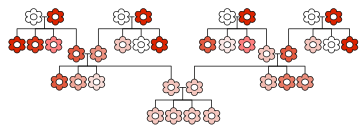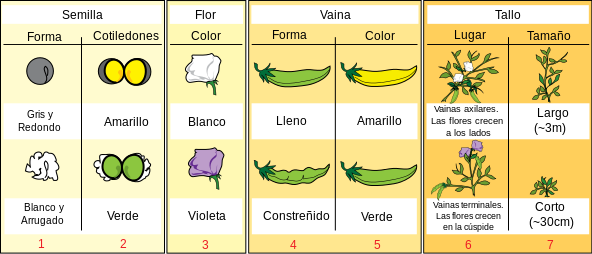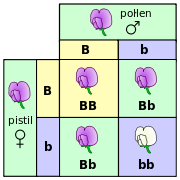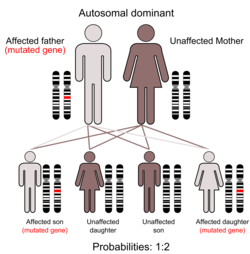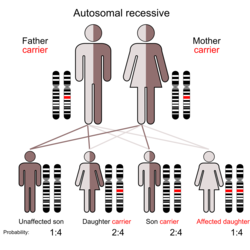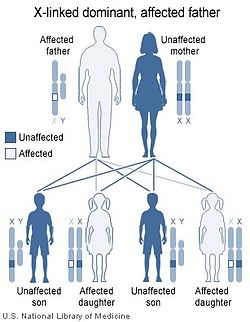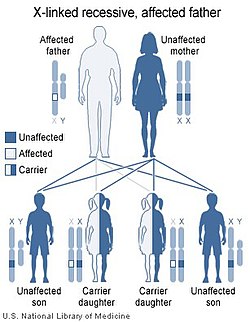Biological Anthropology/Unit 1: Evolutionary Theory/Mendelian Genetics
Contents
IMPORTANT NOTE: THESE PAGES WILL NO LONGER BE UPDATED. THEY HAVE BEEN MOVED TO PRESSBOOKS AS PART OF A COLLEGE INITIATIVE TO COLLECT OER MATERIALS IN ONE PLACE FOR STUDENTS.
Mendelian Genetics
In the previous section (Cell Biology and Molecular Genetics), we explored the mechanisms of biological variation and evolution at the most fundamental level -- cells and DNA.
In this section, we are going to look at how genetics functions for individuals. This field of genetics is often called Classical or Mendelian Genetics. It focuses on how various traits are passed from one individual to the next.
Some working vocabulary
Locus (sing.) and Loci (pl.): the specific position of a gene on a chromosome
Gene: a discrete unit of a DNA sequence that codes for a protein (or polypeptide) or for a characteristic, process, or trait
Allele: alternate forms of a gene at a given locus (ex. T and t)
Genotype: the genetic makeup of an individual
Phenotype: the outward expression of the genotype, as affected by the environment and culture of an individual
Dominant allele: an allele that masks the effect of other alleles in the phenotype (ex. in the case of Tt, T masks the effect of t)
Recessive allele: an allele that is masked in the phenotype unless present in a double dose (ex. in the case of tt, there is no T to mask the effect of t)
Codominant allele: both alleles are expressed in the phenotype (ex. in the ABO blood types, there are three alleles (A,B,O); A and B are codominant alleles)
Homozygous: two of the same alleles at a given locus on homologous chromosomes (ex. TT or tt)
Homozygous dominant: both alleles are the dominant allele (ex. TT)
Homozygous recessive: both alleles are the recessive allele (ex. tt)
Heterozygous: two different alleles (ex. Tt)
Note: Capital letters are usually shorthand for the dominant allele and lower-case is usually shorthand for the recessive allele when discussing Mendelian genetics.
Types of traits
Traits come in two types: Simple, also called Mendelian or discrete traits, and complex, which are sometimes called continuous or quantitative traits.
Simple traits
These are either/or traits (they usually have 2 phenotypes):
- The trait is either present or absent (e.g., hairy pinna).
- or the trait is one state or the other (e.g., attached or unattached earlobes: see image).
- It's controlled by one gene, which has one effect.
- They cannot be changed.
- There is little to no influence from the environment.
- They have a finite number of genotypes, usually very small. For example, 1 trait with 2 options (T and t) = 3 genotypes (ex. TT, tt, Tt).
There are approximately 4000 traits identified as discrete or simple traits of inheritance.
Some additional examples include:
- Soft vs. flaky earwax
- Widow's peak
- Blood type
- Dimples
- Chin cleft
Complex traits
- These traits have a continuous distibution (e.g., height: there are people ranging from short to tall, not just short and tall).
- The phenotype is the result of two factors; the number of loci involved and environmental influence (this includes culture).
- The trait is influenced by more than one gene; this trait is referred to as polygenic).
- Depending on the number of genes involved, there can be many genotypes. The more genes that are involved, the finer the genotype categories until they converge into a continuous distribution.
1 gene = 3 genotypes
2 genes = 9 genotypes
3 genes = 27 genotypes
4 genes = 81 genotypes
- It's often difficult to try to divide them into categories due to an infinite number of phenotypes
The opposite of this, where one gene has multiple effects, is called pleiotropy.
Due to the large role that the environment plays in complex traits, we have a statistical concept in genetics called heritability.
Heritability is the proportion of the total variation observed in the population that can be attributed to genetics rather than to the environment. You can explore this concept more if you so choose: Heritability and height.
Gregor Mendel and his peas
For simple traits, it is easy to trace patterns of inheritance and use them to show how traits are passed on from one generation to the next.
However, there was a contemporary of his that Darwin didn't know about, a monk named Gregor Mendel (pictured right), who figured out something important about simple traits and genes.
Mendel is famous for a series of experiments that he completed with pea plants (between about 1856 and 1868) and the paper that he wrote about it (Experiments with Plant Hybrids). Unfortunately, despite the fact that Mendel published this work in 1865, it was relatively unknown until 1900. What he concluded was that genetic information is inherited in discrete units (he called them "factors", we call them "genes"). His work demonstrated that inheritance is non-blending or "particulate".
Mendel's pea experiments
Mendel first noticed that pea plants have seven simple traits:
1) Seed shape and color
2) Cotyledon color
3) Flower color
4) Pod shape
5) Pod color
6) Location of pods and flowers on the stem
7) Plant size
He also noted that when one selectively bred the plants with the various traits together, he could predict the ratios of offspring characteristics.
For example, he noticed that when he bred pure-bred plants with violet flowers with those with white flowers, the first generation (F1) all had violet flowers. If blending inheritance was functioning, one would expect all of the flowers to be a pale violet, halfway between the original violet and white.
Then when he took those F1 violet-flowered plants and bred them together, the second generation (F2) had a ratio of 3:1 violet to white flowers (there were still no pale-violet hybrids). This phenomenon was consistent across the pea plants' other six traits.
He determined that this is what was going on:
- The pure-bred violet plant was homozygous for its violet allele (BB).
- The pure-bred white plant was homozygous for its white allele (bb).
- So, when the two plants were crossed -- all of the offspring (F1) were heterozygous (Bb).
- And, when the heterozygous (Bb) offspring were crossed, this was the result: the genotype is 1 BB: 2 Bb: 1 bb and the phenotype is 3 violet: 1 white.
Note: This little diagram is called a Punnett square (after an early 20th c. English geneticist named Reginald Punnett). They're really pretty simple to construct. One just puts the alleles of each parent (one parent on the top and the other down the side) and then you fill in the boxes of what the offspring will be. In order to devise the ratios of the various genotypes and phenotypes, just count the number of boxes of each.
For further information on how to construct Punnett squares, go here or watch this video from Bozeman Science.
Mendel's very thorough experiments (some estimates say that he bred approximately 29,000 pea plants) lead him to write these four postulates.
Mendels' postulates
1) Genetic characteristics are controlled by genes that exist in pairs in individual organisms.
- The pairs of genes that he's referring to are those on each pair of homologous chromosomes.
2) When an individual has two different genes for a particular trait, only one is expressed and is dominant to the other, which is recessive.
- In other words, when an individual has a T allele and a t allele, the T allele will mask the expression of the t allele. Therefore, the phenotype expressed will be that of T.
3) During the formation of gametes (AKA sex cells, sperm and eggs), the genes separate, or segregate, randomly so that each sex cell receives one or the other with equal likelihood.
- In other words, the offspring have an equal likelihood of getting a particular gene from one parent or the other.
- This is also known as "Mendel's Law of Segregation".
4) During the formation of gametes, segregating pairs of genes assort independently of each other.
- In other words, the segregation of any particular pair of genes does not affect the segregation of any other pair.
- This is also known as "Mendel's Law of Independent Assortment".
Some examples of inheritance patterns in humans
Autosomal dominant traits
- An individual only has to have one copy of the allele in order to exhibit these traits.
- If an individual has the trait, then at least one of their parents has the trait.
- Both males and females are affected equally and should be capable of transmitting the trait.
- There is no skipping of generations.
- If one of the parents has it, then on average, 50% of the children will show the trait.
Examples of this include:
Autosomal recessive traits
- An individual needs both recessive alleles to express the trait
- Heterozygotes are considered to be "carriers"
- Both males and females should be affected equally and should be capable of transmitting the trait.
Examples of this include:
Cystic fibrosis, sickle cell anemia, and Tay Sachs disease
Sex-linked traits
- Remember that all females have two X sex chromosomes (XX) and males have one X and one Y sex chromosome (XY)
- These traits are inherited on the sex chromosomes (X and Y)
- There have different rates for males and females
There are three types:
- X-linked dominant
- X-linked recessive
- Y-linked
X-linked dominant
- Both males and females will express the trait if they possess at least one copy of the allele.
An example of this is:
X-linked recessive
- For females, they need two copies of the allele to express the trait, but only one to be a "carrier".
- For males, they need only one copy of the allele to express the trait. They will pass the allele down to all of their daughters.
Red-green colorblindness and Hemophilia A
Y-linked
- No female will carry or express the allele (because they don't have a y chromosome)
- All sons will carry and express the allele (because they must inherit a y chromosome from their father)
An example of this is:
References
Klug, WS and Cummings, MR. 1991. Concepts of Genetics, 3rd. edition. Macmillan Publishing Company: New York.
